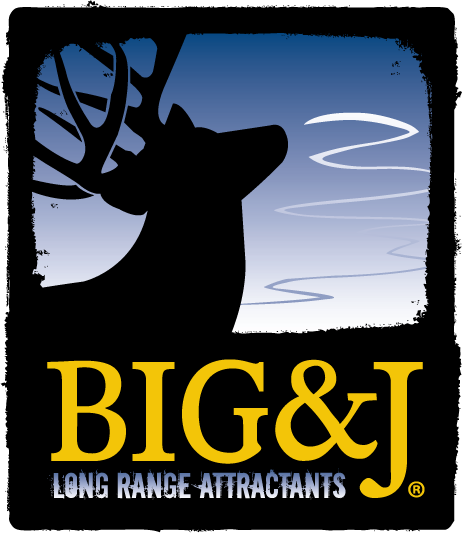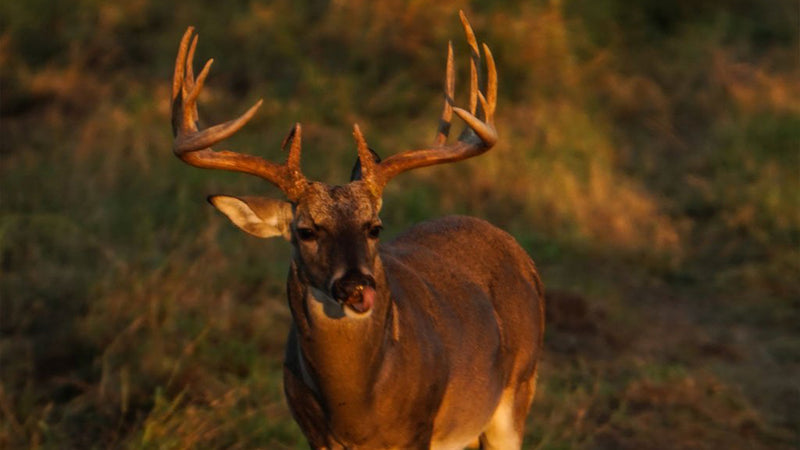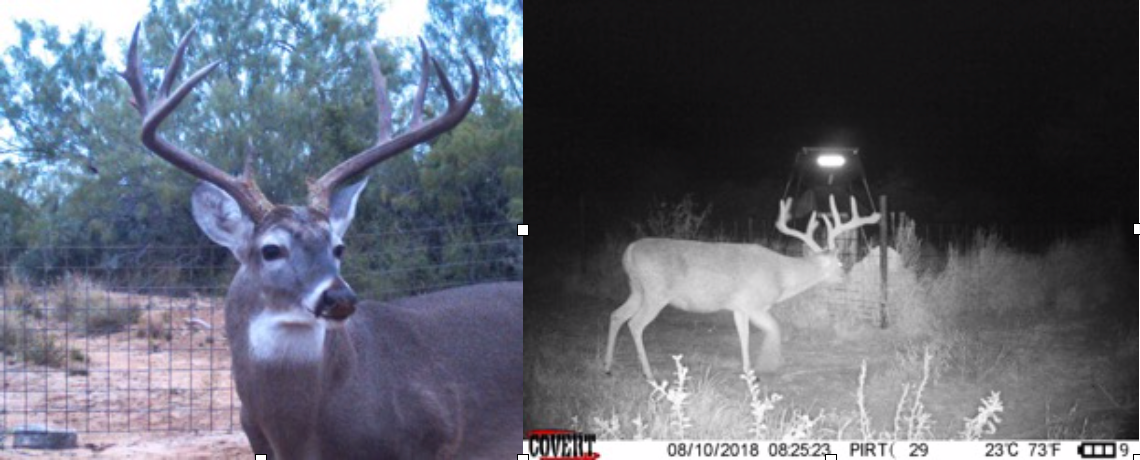
By Josh Kinser
Property – 2,400 acres
Region – South Texas

At the end of every hunting season, similar questions appear all over hunting forums
and Facebook groups. Frequent questions are “What do you feed your deer in the offseason?” “What’s better – protein vs. cottonseed or split peas?” and “I finally started to feed protein and the deer haven’t touched it. What should I do?”
I’ve had the fortune to learn from and spend a lot of time with several renowned
wildlife biologists. One little tidbit that I always try to pass on is what Rick Taylor used to say when he helped me manage a few ranches, “There is no silver bullet. It’s all about the pieces you put together in your management program and the key is sticking with the plan.” So, when I’m asked whether I use protein or cottonseed – the answer is both. They are both pieces to a good plan. I have done this for years, and it works for me. I’ve taken bits and pieces from others and added my own little twists to create a plan. Off season feeding that consists of protein, cottonseed and minerals gives me good results.
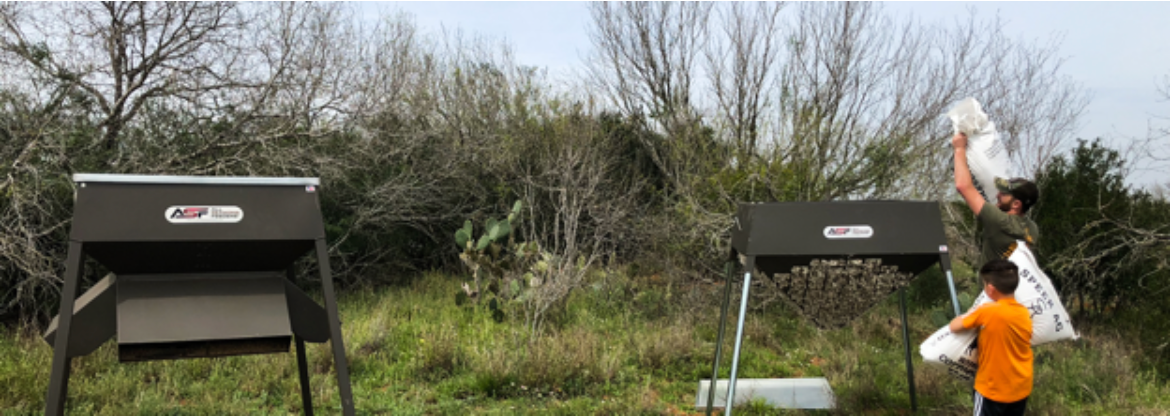 Protein feeder and cottonseed feeder placed side by side. 20 yards to the left is also a water well and tank that has multiple deer trails intersecting at this location.
Protein feeder and cottonseed feeder placed side by side. 20 yards to the left is also a water well and tank that has multiple deer trails intersecting at this location.
Feed & Mineral Site Placement
I like to remind folks that when they are deciding on where to place any feed, mineral or bait to think about it like you would bass fishing. Say you have a spinnerbait on – you can cast that thing all day long out in open water and never get a bite. You need to get that spinnerbait right up against the stumps where those big bass are. The same is true with deer – if you put feed where deer aren’t present or passing through, it is going to be tough going. You are probably going to be disappointed and then, blame the products. Deer, especially bucks like having a safe place to eat. Place your sites near known travel routes and on the edges of bedding areas. I like to place my mineral sites near either water or other feeding areas.

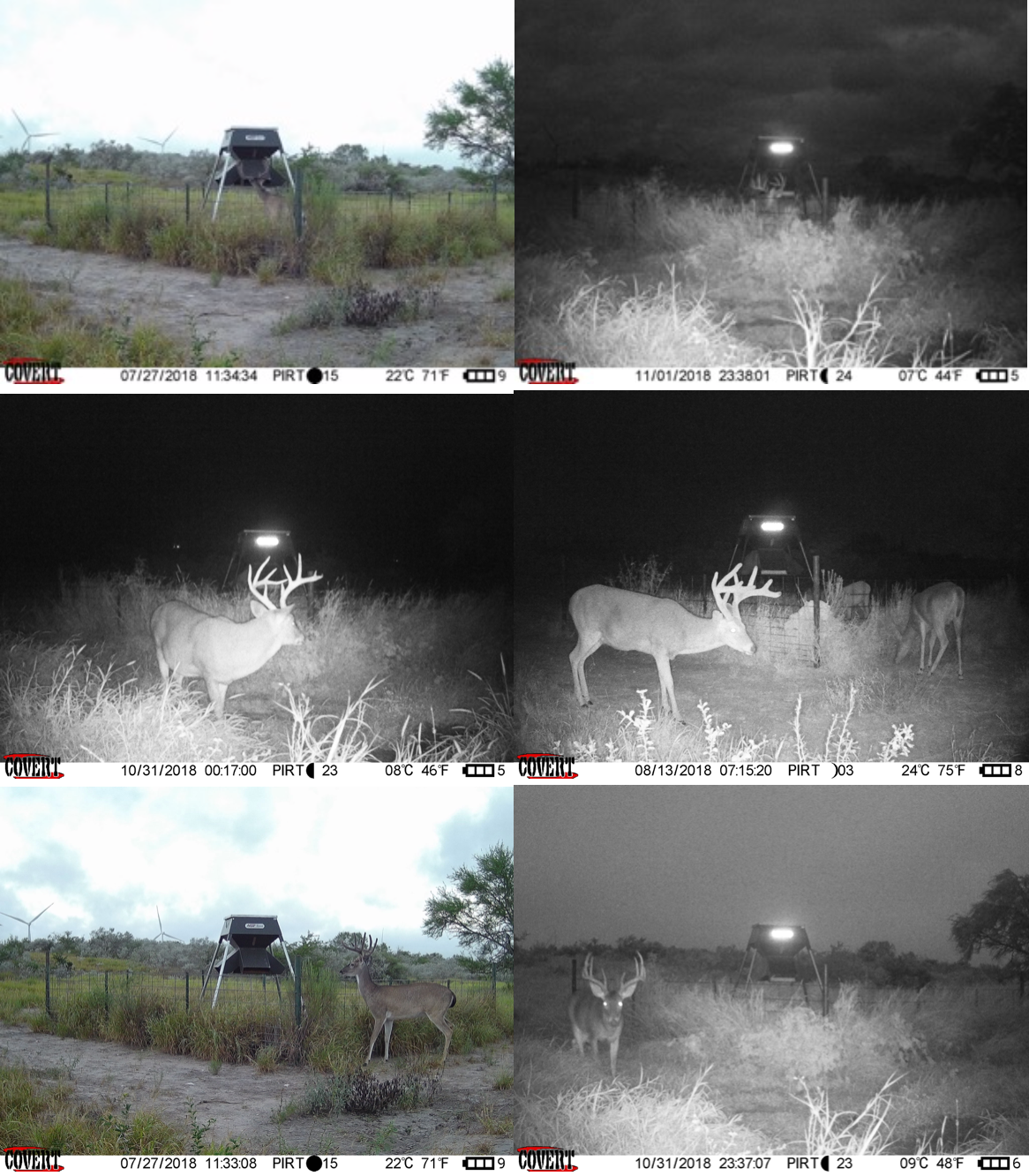
I keep a mineral site going during the offseason at this very busy feed station and travel corridor. At this spot, I splurge and feed straight BB2 year-round and the mature bucks love it. I also have a portable water system that I fill about once/month at this site.
Protein
Protein pellets are widely fed across the country but oftentimes hunters and game managers struggle with getting deer to eat it. Protein pellets aren’t often all that tasty to deer and don’t have a real strong aroma to bring deer to it. Most protein also lacks a key ingredient – fat. Deer need fat. Starting at the end of February, I mix either Big & J’s BB2 or Pour It On with protein pellets. I usually do a 50/50 mix of Big & J (either BB2 or Pour It On) with protein pellets. This adds fat (7.5% in BB2) to the feed, keeps the cost down and pulls deer from further away with Big & J’s attractant aroma. There are some honey holes though that I feed straight BB2 all year round.
This also helps me once hunting season rolls around again. I have taught deer what Big & J smells like, they know the taste and they know how much more energy they get from eating BB2 and Pour It On. I can throw it on the ground during hunting season and they come running, especially during the rut – when the bucks are getting run down.
I run protein during the offseason in both gravity and some of All Seasons’ Timed protein feeders. Once the season begins, I let the gravity feeders run dry but do still keep a mix of Big & J and corn running in those timed protein feeders. They fill the trays and times set by me, which saves on the amount of feed lost to varmints at night. I know it is inevitable that raccoons are going to get some feed from me, so I actively stay on top of trapping as many as I can at every feed site. This timed function helps keep bucks, needing that energy from the feed, moving a little better in daylight hours too.
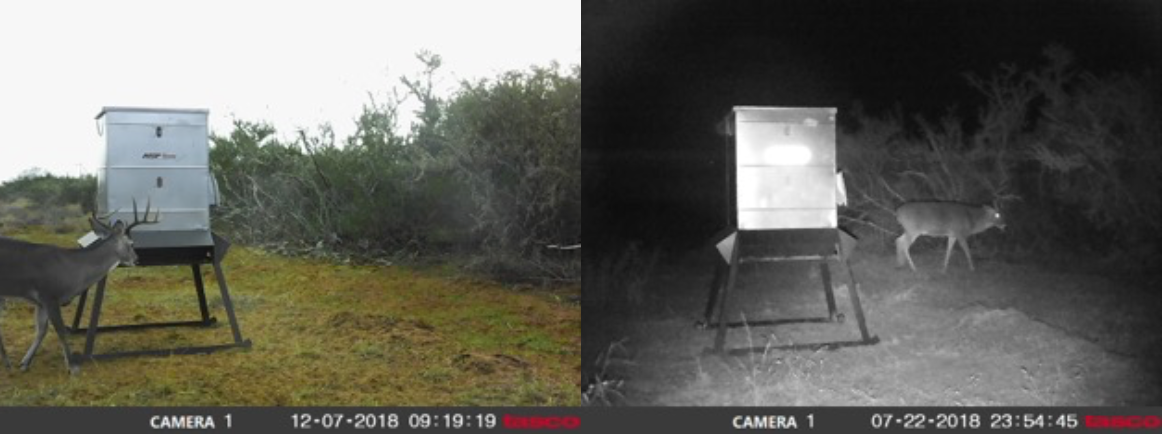
Bucks coming into feed out of an ASF Electric Stand & Fill. This feeder is filled with a combination of Big & J’s BB2 & corn during the hunting season and BB2 and protein pellet mix in the offseason.
600lb Electric Stand & Fill Feeder™
• Perforated feed tray to keep feed fresh and dry
• Can feed up to 6 times a day
• Dispenses 12lbs of feed in 10 seconds
• Protein feeder head holds up to 75lbs of protein
• Skids for easy relocation
• Easy-access control unit located on the side
• Solar wires hidden so varmints cannot access them
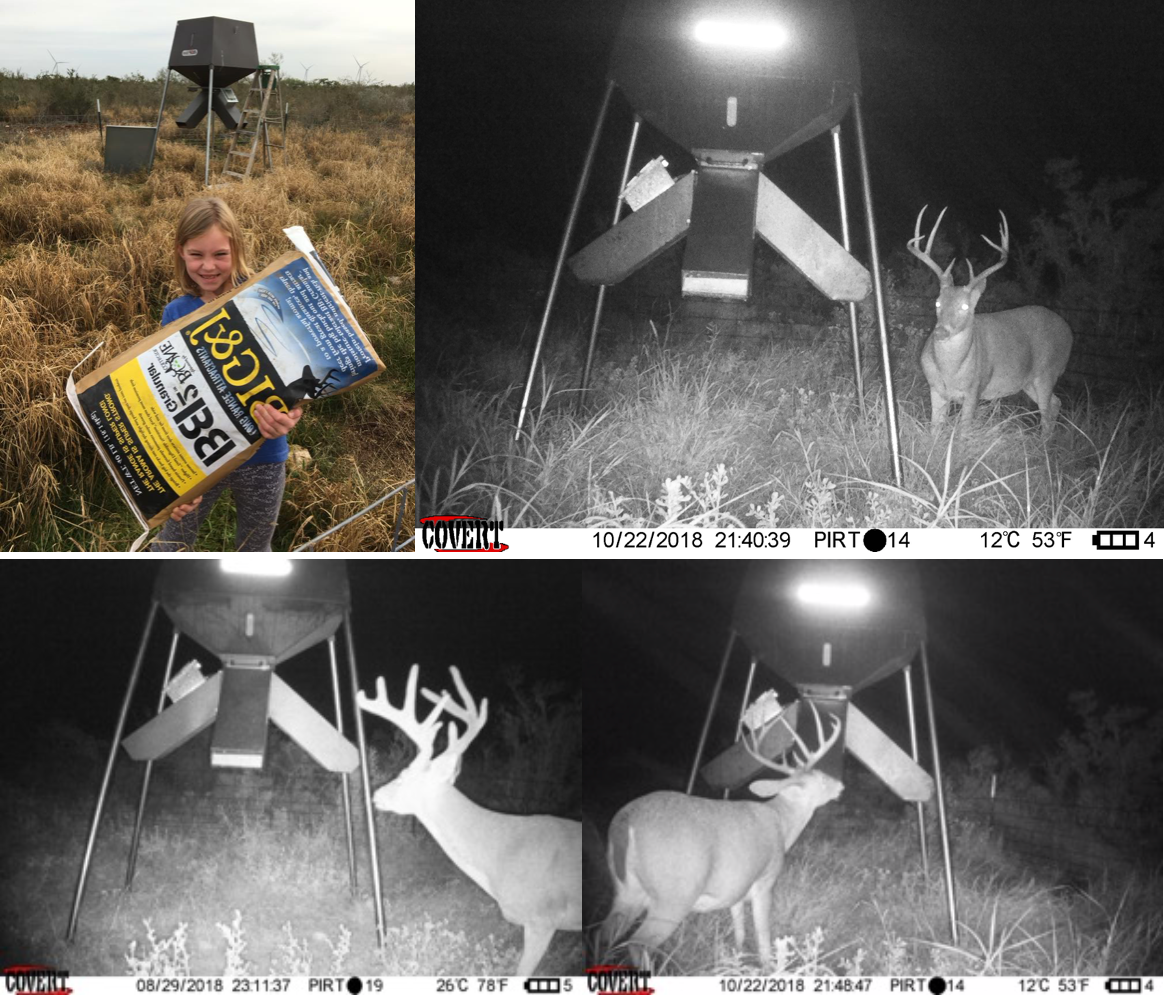
I keep this spot fed the same all year round with BB2 and protein pellet mix in the ASF 1,000lb Pro Evo w/ Timer. I run a stronger mix of BB2 at this spot about 70/30 of BB2 instead of the usual mix in other places. The BB2 flows great through this system and it isn’t uncommon to have 15-20 different bucks on camera at night visiting this spot.
1,000lb Electric Pro Evo Feeder w/ Timer
A heavy-duty protein feeder designed to keep varmints and rain out! Holding 1,000lbs of protein, this feeder is for those who are serious about supplemental feeding. Being electric, this feeder allows you to set specific feed times, regulating your feeding as you desire. The electrical components of this feeder are stored in an enclosed housing that ensures they will stay dry and out of the way of your animals. This is the most weather resistant and varmint resistant feeder on the market!
Feeder Includes:
• Evolved protein head design
• 2 Elongated sight glasses
• New lid for easy filling
• ASF Timer to regulate feeding
• Shut off gate for easy clean out
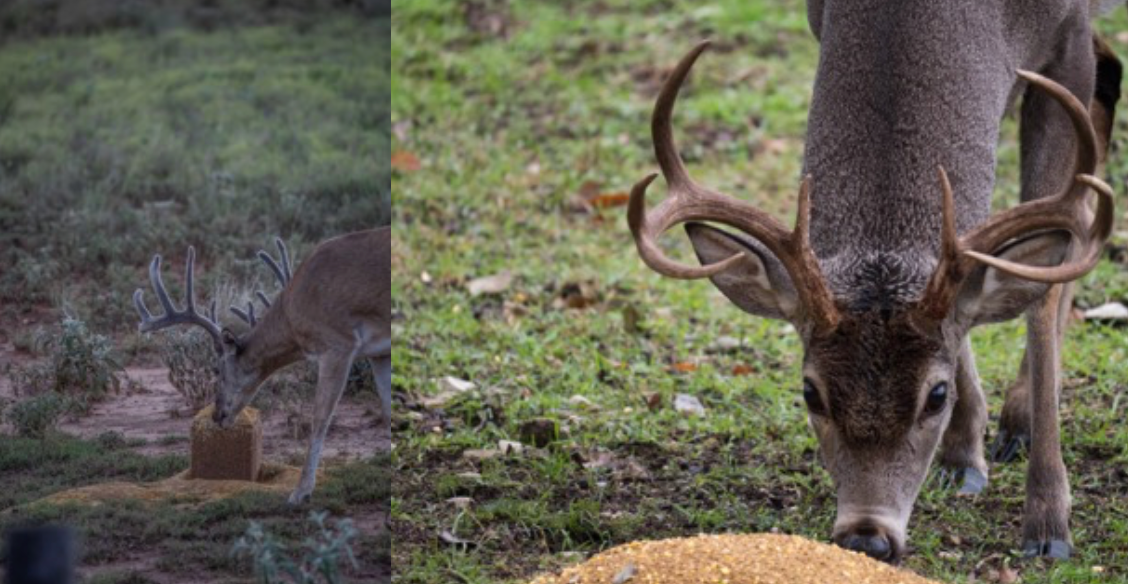
(Left to Right) A buck gets a summer snack mix of the BB2 Cube and Granular in South Texas; A Texas Hill Country buck pounds some BB2 in early October.
BB2 granular and cube – Aside from the value as an attractant BB2 is over 90% digestible which is greater than corn. In addition, the energy comes primarily from digestible fiber and fat instead of starch and fermentable carbohydrate. This leads to a near zero chance of acidosis or digestive upset. The protein content of BB2 is guaranteed to be 18% as a minimum and is comprised of approximately 70% UP and 30%DP. Undegradable protein is more than likely a limiting factor when considering feedstuff availability vs requirements of deer. Remember not all protein is created equal and deer have adequate degradable protein supply from what they are grazing. Given the energy content and the protein content, BB2 is the total package in attractant form; however; additional mineral supplementation is needed to maximize genetic potentials of production. When to feed: year-round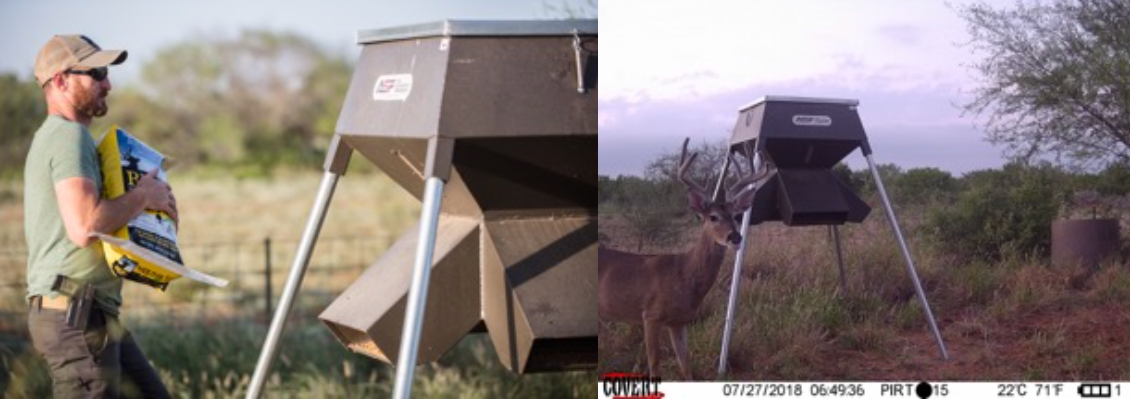
This is one of my Pour It On spots. I mix the Pour It On with protein pellets in the spring and summer and then switch to a corn mix with it during hunting season. It’s great to see young bucks with a lot of potential filling their bellies with this mix. I don’t add mineral sites where I feed Pour It On. I feel they get the extra minerals in that feed and in the past, I could see how much less they would hit mineral sites that were adjacent to Pour It On sites. I just take what mineral I would have put there and place somewhere else.
Pour It On – On the surface Pour It On is the same as BB2, but that is where the similarities end. This product is perhaps the biggest game changer when talking about science in the bag and complete nutrition on a cellular level. On the surface the nutrient profile when looking at protein and fat may be similar to regular BB2 but the devil is in the details. Enhanced with the first and second limiting amino acids (building blocks of protein) in protected form. Protected amino acids are scientifically proven to make it through to the absorption sites for maximum biological potential. In addition, Pour It On is fortified with organic sources of Zinc, Copper, Magnesium, and Manganese which have greater bioavailability than standard sources. When to feed: year-round.

Filling one of my 500lb. cottonseed feeders at the end of February. For me, the work put in during the early spring is so important. Some of these bucks after a long rut have lost 50-60lbs. I want to get their weight back up as fast as possible.
Cottonseed
There are a lot of advantages to feeding cottonseed. There are a lot of pains in the rear to feeding cottonseed and there are a lot of myths. First and foremost, I love feeding cottonseed but I know that it has almost no minerals. Just a reminder about what antlers are made of – 65-75% protein/30-35% minerals. Cottonseed is very high in crude protein (*crude protein is the combination of a products’ degradable (DP) and undegradable protein (UP) content.) In short, both proteins are major supplemental need for deer and cottonseed in a great source of both although the percentages of each can vary greatly from one batch of cottonseed to the next. (*If you want to read a more in depth discussion about protein, there is more information at the bottom of this article.) Cottonseed’s abundant and nutritious oil and fat content makes it a great food source for high energy yield and weight gain. The fat content can run between 15-24% and that is awfully hard to come by in natural browse. I love feeding deer this as soon as the rut is over to help them get that weight back on as fast as possible. I feel the fastest way to do that is to have both the protein I described above, mixed with cottonseed feed stations.
I only feed cottonseed mid-February to September. I’m winding down my offseason supplemental free-choice feeding program at that time, so I don’t feed cottonseed until the very end of our hunting season.
Getting deer to eat cottonseed can be really easy or very hard. During the drought in the hill country one year, we picked up a trailer full of cottonseed on a Friday. We went to bed and woke up that next morning to find deer were eating it off the trailer right there in camp. I’ve also struggled to get deer to eat it in places. It doesn’t have much of a smell so you need to attract deer there. Place it near travel routes, pour corn or Big and J attractants around it for the first few weeks of filling it or put it near another feeder or water source. Don’t just go put cottonseed out in some random spot in the woods somewhere. If you do, you are probably going to be disappointed and be one of those guys complaining about cottonseed feeding in the forums.
Finding cottonseed at feed stores can be difficult at times. South Texas seems to have pretty good and consistent availability of it. Some parts of Texas – not so much, although I feel like that is changing for the better. Speer Ag out of Uvalde seems to be picking up production and distribution across the state.
I use All Seasons’ new cottonseed feeders. I live about 3 hours away from the ranch so filling them up with 500lbs. of cottonseed works out better for me. I don’t have to worry about it running out before I can get back down to refill.

ASF Cottonseed Feeder
Minerals
Minerals are an important part of a deer’s needs. Not only to bucks growing antlers, but also to pregnant does who will be nursing during late spring/summer. During the spring, deer usually have changed their diet to match the season – green forbs are both plentiful and filling, but are almost devoid of minerals, and at a time when both sexes need it most.
Mineral supplementation becomes even more important through the spring and summer months. Not just because feedstuffs available are practically devoid of Ca, but also as forages grow mineral content dilutes as the mass of the plant increases meaning that for every bite of grass consumed deer are taking in less mineral than they would during the Fall and Winter. Mineral needs to be available that would provide total dietary Ca and P of approximately 0.6% and 0.3%, respectively. In addition, Ca and P need to be at a ratio of at least 2:1.
- Will Griffin Ph.D., Ruminant Nutrition – Big & J
Currently, I use these two products (Legit & Meltdown) for my mineral sites and put them about 5-10 feet apart from each other. I try to concentrate them around water. I like to have a mineral site for every 100-200 acres of property, regardless of the region.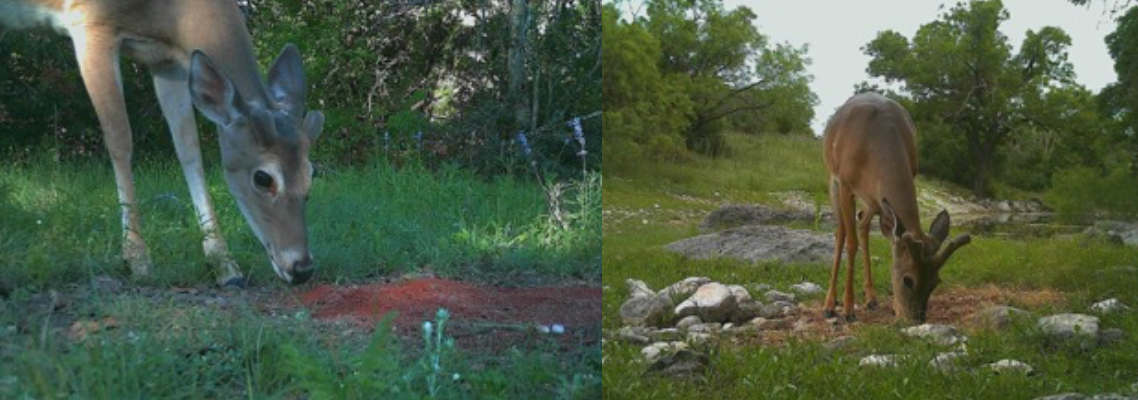
Deer in the Texas Hill Country hitting Legit mineral sites in May.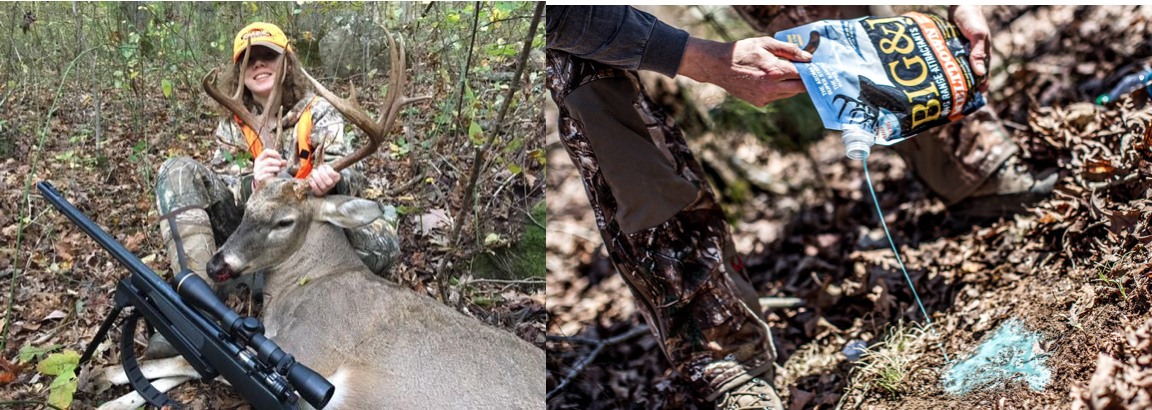
Generally speaking, on the properties I manage the deer lay off of minerals around the end of August. I have friends in Oklahoma and Arkansas though that have deer continuing to frequent mineral sites until mid-November. Learn what your deer need by watching and keep putting it out as long as they still are consuming it. In the picture above, my friend’s daughter killed this buck in late October coming into a Meltdown spot.
Big & J’s Legit – Great source of Ca and P needed for bone/antler growth, meets the deficiencies in the natural habitat. Includes trace minerals that are essential to reproductive function and healthy bone growth/antler growth. Apple flavored for attracting power. When to feed: Late Winter through early Summer.
Big & J’s Melt Down – Great source of Sodium which would be the next part of the puzzle once Ca and P are met. Sodium is needed for cellular function including amino acid (building blocks of protein) transport. In addition, deer have an appetite for Sodium meaning they will consume it even if the body does not need it. When to feed: Late Winter through early Summer.
I start putting out mineral in March although I don’t usually find deer hitting it hard in April in Central and South Texas. In these areas, this continues through mid to late August and then intake subsides. It really comes down to the mineral content in your soil and what the deficiencies are. I know plenty of folks that still have deer coming to their mineral sites in other states all the way until November. It just depends on where your location.
Please don’t mix your mineral product with feed – not even corn. I get questions about why that didn’t work for people all the time. I tell them, imagine taking a steak and then dumping a ton of salt on it before handing it to your dinner guest. They are only going to be able to take a bite or two. They may not even come back over to your place for dinner ever again. Deer are not going to consume mineral like they will feed. They only need a little at a time. Some feed does have mineral in it but at percentages that are consumable. I can’t tell you how many times I have had people dump a bag of mineral/salt onto a pile of feed or into a feeder and wonder why the feed wasn’t consumed at the same rate.
Food Plots
I’m sure several folks are reading this and throwing their hands up and saying, “But, what about spring food plots?!?!” Well, most of us in South Texas would if we could. We have good soil but our rain is inconsistent and irrigation isn’t cheap. That said, our weather pattern the last 3 springs and early summers have been different and we have gotten a lot more rain in places than we are accustomed to. For this reason, I am going to attempt a few plots of a bean, pea and lablab mix. I know it is a risk but I would love to have some plots in the middle of the property. Even if I could have these types of plots, I wouldn’t replace any my feeding regimen currently listed above. Rain isn’t guaranteed. I want it as another supplement – one more piece to add to the comprehensive plan and providing more options for more deer.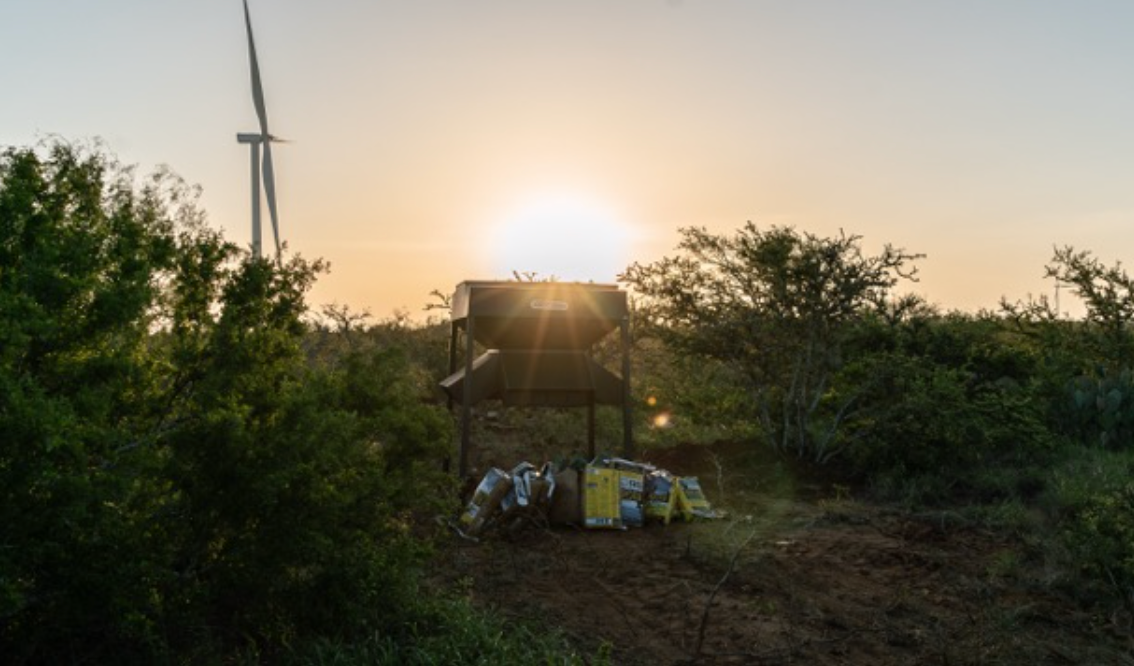
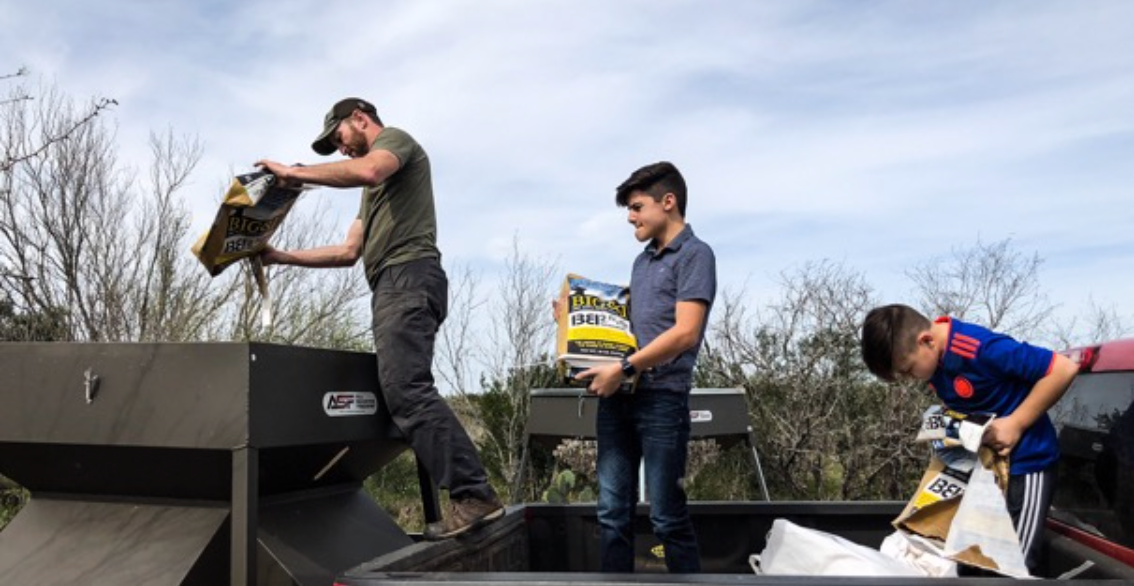
Offseason prep & nutrition = happy hunting. Remember, Rome wasn’t built in a day. Being consistent in your feeding and what you feed is of great importance – and not just during the season but season after season.
More In-Depth Talk about Protein and Mineral for Us Deer Nerds
By Will Griffin, Ph.D., Ruminant Nutritionist, Big & J
All protein is not created equal…
Protein is a critical requirement for maximizing the potential of your deer herd. Not only is it important for muscle health and weight gain in deer, but protein is also critical for antler growth. In general deer need to consume a diet that is 16% protein; however, at certain times of the year, the requirement may be higher or lower based on the cycle of production (recovery, reproduction, growth). For example, hardened antlers have a protein composition of approximately 45%. This makes protein a critical component for antler growth during the spring and summer when antlers are developing. A deficiency in protein during times of antler development will lead to a reduction in inches.
All protein is not created equal. For deer, the type of protein is very important and feedstuffs used for protein supplementation need to be evaluated based on the amount of degradable protein (DP) and undegradable protein (UP). Degradable protein is a protein that is produced by the animal from digestion of the bacteria in the rumen and typically is not of a concern when discussing protein requirements for ruminant animals as long as energy is not limiting. Undegradable protein is true protein provided to the animal from feed/supplement that passes through the rumen to the small intestine unaltered. Crude protein is a combination of both DP and UP and is a common measure shown on feed labels. Crude protein is measured by the nitrogen content of the feedstuff and does not describe if the protein is DP or UP, therefore, it is important to be informed of the protein composition (DP or UP). In conclusion, the type of protein needs to be considered when making decisions on how to manage food plots, feeds, and attractants to supplement deer herds. Both DP and UP requirements of deer herds need to be met to maximize genetic potential.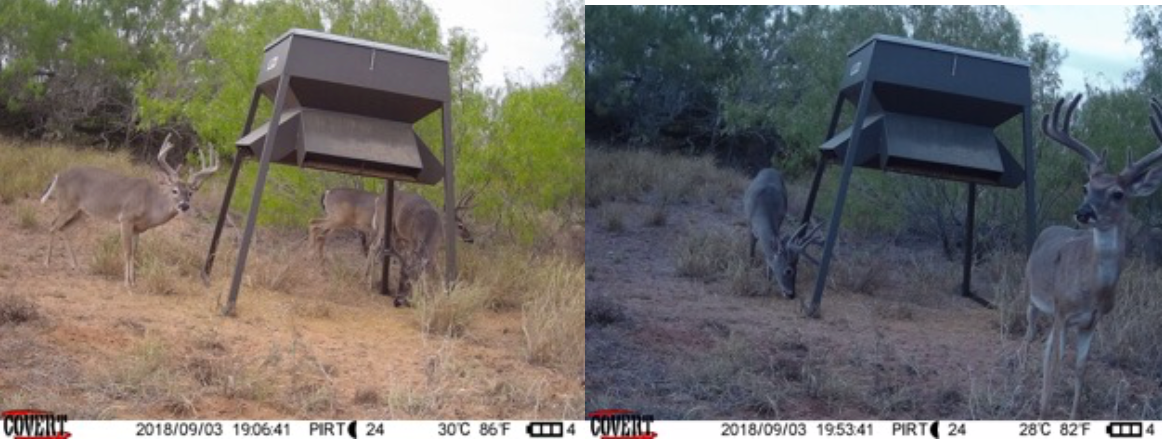
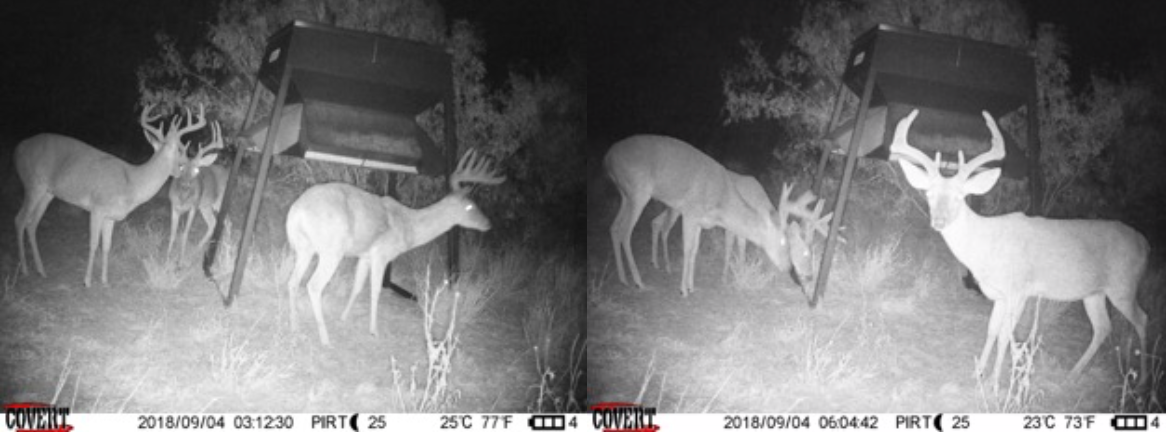
Bucks feeding at the end of summer, putting on as much weight as they can in prep for the marathon of the South Texas rut. BB2 and protein pellets are mixed in this feeder. Remember that BB2 tastes better (more palatable, has an exponentially further reaching aroma and contains 7.5% fat in addition to 20% protein.
Minerals, not just salt…
In their habitat feedstuffs consumed by deer mostly meet the needs of the animal but some gaps need to be filled. Perhaps the two most important minerals to consider are Calcium (Ca) and Phosphorus (P). These two minerals are critically important for bone health not just in antlers but in skeletal structure as well. During the time of mineral deficiency deer will pull Ca and P from their bones in order to meet the needs of the rest of the body. When considering impacts on antler growth the most important thing to consider is that if the skeletal system is not replenished than antler development and growth will be delayed leading to fewer inches. Mineral composition of antlers is approximately 20% Ca and 10% P. Interestingly looking at the ratio of Ca and P in antlers will also tell you the proper ratio for deer in their diet which needs to be at 2 parts calcium to 1-part P.
Other minerals are important as well but are not needed at the same quantity as CA and P, they include zinc, magnesium, copper, and the list goes on. In an ideal situation, trace minerals, which by its name suggest that they should be fed in very small quantity or trace amounts, are essential to reproductive, immune and growth functions. Considerations to make when looking at trace minerals is the bio-availability or if the animal can absorb them. If the animal cannot absorb these ingredients than they just pass out of the animal and the money for supplementation in order to increase herd health or performance of deer has just been wasted.
In foods deer consume, mineral content is low, especially Ca, making it a primary concern when consideringa mineral supplement. Without the addition of Ca as an ingredient, most products on the market today used as deer supplements/attractants are devoid of Ca. Phosphorus can be more prevalent in forage but would mostly be seen in food plots where legumes (Alfalfa, Clover, etc…) are heavily favored. Phosphorus in food plots help with meeting the needs but in most cases supplemental P is still needed to meet the deficiency depending on the time of year.

